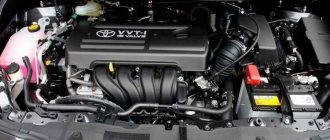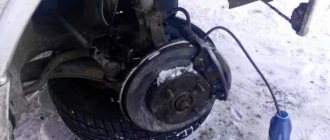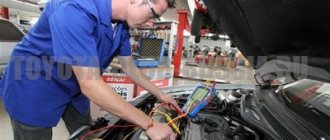Bleeding the brakes on a Toyota with ABS is not much more difficult than on its standard version. To remove air from the braking system of a car that has ABS, you should understand how it works specifically for your model. The reason for this need is that depending on the model, the circuit may have some differences.
For example, if the hydraulic valve block and the hydraulic accumulator with the pump are located in the same block, then the procedure for bleeding the brakes will be similar to its implementation on a regular car where there is no ABS system.
Types of ABS system on Toyota cars
There can be two of them, with differences in design and pumping methods:
- ABS consists of a hydraulic valve block, a pump and a hydraulic accumulator. Such a system can be very easily pumped even in your own garage;
- All of the above elements are placed in different blocks, with additional modules, and are pumped only in a service station. You will need a diagnostic scanner to monitor the modulator valves.
Taking into account these features, you can understand that first of all you should find out the type of ABS for each specific Toyota car model. The fact is that the following instructions will only be relevant for its standard version.
Brake system maintenance
In order for the vehicle to function properly, it is necessary to monitor the wear of its components. This primarily concerns brake pads. Their timely replacement will help extend the life of the brake discs, which must be replaced if worn.
The second need is to regularly pump the vehicle so that it works reliably and properly in an emergency.
General principle of pumping
The actions are performed in this order:
- Find and remove the fuse in the block responsible for ABS operation;
- Unscrew the wheel and find the RTC fitting, which is responsible for bleeding the brakes;
- Start bleeding the ABS brakes with the pedal depressed;
- Turn on the hydraulic pump, as indicated by the ABS lamp lighting up on the instrument panel, and wait until the air is completely released;
- Tighten the fitting and release the brake pedal. If the ABS light goes out, then everything was done correctly and all the air has escaped.
More: Should you flush the engine before changing the oil?
Recommendations for choosing brake fluid
The brake system of the Toyota Camry 40 must only be filled with fluid that complies with the FMVSS 116 standard. The types of fluid used and its performance characteristics are shown in the table below.
| Brake fluid type | Characteristics |
| DOT 3 | DOT 3 brake fluid should only be used as a last resort. Its composition has a very bad effect on the car's braking system. The driver should also remember that it is not recommended to fill in DOT3 if the temperature drops below – 30°C. |
| DOT 4 | The best option for the car owner. Good brake fluid with high quality and affordable price. |
| DOT 5.1 | Even though brake fluid has the same composition as DOT4, it has a number of advantages. For example, DOT 5.1 has a higher boiling point. |
This is interesting: Technical characteristics of the 2AD-FTV engine fuel system for testing and adjustment work on Toyota RAV4
The process of replacing brake hoses on a car
Replacing the brake hoses itself is not difficult; I did not change the washers under the hoses, which in theory should be copper, I installed the old ones, which I had were aluminum, double ones. Before unscrewing the hoses, we treat all connections with WD40.
Processing connections with WD40
Next, loosen the bolt connections a little and pull out the brake hose retaining bracket.
Loosen the brake system tube and pull out the locking bracket.
Then we finally unscrew all the connections and install new brake hoses. And tighten it with the force specified in the auto instructions.
Bleeding the car clutch
We bleed the clutch in the same way, press the clutch pedal several times and bleed the old DOT4 brake fluid through the clutch bleeder nipple on the clutch cylinder. At the same time, do not forget to constantly monitor the level of brake fluid in the reservoir so as not to air the system.
Bleeding the clutch on a Toyota Corolla 2005
At the same time I ordered it from existential and installed caps on the bleeder fittings; I had two caps missing. I haven't seen any caps in stores. I ordered a non-original: Metzger air valve bolt article Z 0125 , costing 32 rubles 14 kopecks for two caps. The original Toyota costs 150 rubles each, but it’s not worth it.
Cap (air valve bolt) Metzger article Z 0125
How to properly bleed brakes on a Toyota Corona
The brake system is one of the key components of the correct and safe operation of a car. Any malfunction in the brakes can result in a problem or tragedy for all road users. To avoid problems while driving, it is necessary to constantly monitor the condition of all parts of the system: discs and pads, and especially the brake fluid.
Brake bleeding is required in the following cases:
You noticed that the brake pedal has become “softer” and its travel has increased. You have repaired or serviced the brake discs, replaced the brake pads, or completely tuned the brake system.
In these cases, it is definitely necessary to bleed the brake system to remove air. Procedure for bleeding the brakes
As always, you have a choice of how to level up. You can contact a car service. There you will be bled using a brake bleeder. A modern and efficient unit designed to remove air from the brake system. The professional brake bleeding device is equipped with adapters that allow it to work with many existing models of cars and trucks.
The second option is to bleed the brakes yourself. In principle, the procedure for bleeding the brakes is the same for any system. You will need a simple homemade device for bleeding the brakes from a syringe, tubes (hoses) and a plastic container. Options for pumping yourself: two people or one person, i.e. you yourself.
Scheme for bleeding the brakes: you should start from the wheel that is located at a far distance from the GTZ.
- rear right wheel mechanism;
- front left wheel mechanism;
- rear left wheel mechanism;
- front right wheel mechanism.
Bleeding the brakes with a partner
Remove the plug that covers the brake bleeder fitting and put a transparent hose on it. We lower the free end of the hose into a container partially filled with brake fluid.
The partner presses the brake pedal with intensity 3-4 times and leaves it pressed. You slightly unscrew the bleeder nipple until the brake fluid begins to be forced into the container. You can determine the presence of escaping air by the bubbles in the liquid in the container.
After this, tighten the bleeder fitting and repeat this procedure in the same order on the other wheels. Replace or add brake fluid of the type recommended by the car manufacturer. If after bleeding the brake pedal is still “soft”, check the wear of the brake pads, or repeat the bleeding procedure again.
Bleeding brakes without a partner
This task is quite labor-intensive, but sometimes this happens. As a device for bleeding the brakes, you will need: a brake fluid reservoir cap identical to yours, a syringe and a container. Here's the design:
We seal the syringe into the reservoir cap using a “sealant”, then screw this device onto the brake reservoir, having first filled the syringe with brake fluid. We unscrew the fitting at the outlet of the circuit that is to be pumped. We install a container to collect the leaking brake fluid. Then use a syringe to inject brake fluid.
Another way to bleed the brakes without an assistant will require you to have a block or other support. After filling the brake reservoir, you pump the brake pedal several times and hold it depressed. Then perform the standard procedure: unscrew the fitting and wait until the flow of brake fluid becomes slightly uniform. Close the brake bleeder screw.
Release the brake pedal and repeat the procedure. After bleeding the brakes, add brake fluid of the required grade. All. You can go for a test drive of the brake system, while observing safety precautions.
1. Unscrew the cap on the brake fluid reservoir. 2. I add brake fluid to the reservoir until it is full and screw on the cap of this device. 3. We connect the pump tip (on the hose) to the inflated spare tire. Now, if there is a compressor, I connect it directly to it, and set the pressure in the system to 3 bar. 4. We carry out pumping as indicated in the first post.
The features of this pumping boil down to monitoring the brake fluid in the reservoir.
Continuing the topic, answering the question about the need for a running engine when bleeding brakes with ABS. There is no difference, it has been checked several times, I bleed with the engine running and consider this bleeding to be correct, some simply remove the fuse responsible for the ABS and bleed, others do this with the engine not running. Excerpt from an article on bleeding the brake system with ABS.
Bleeding brakes with abs
Thanks to technological progress, almost all modern cars have a braking system with ABS function. The automatic locking system protects the vehicle's wheels from locking during emergency braking by controlling their rotation speed. Thus, the wheel sensors transmit impulses to the ABS electronics unit, the reaction of which regulates the entire braking process.
Monitoring the health of the car, including the brake system, is very important. Bleeding ABS brakes is necessary to remove excess air from the hydraulic drive, which could get there during repairs or replacement of brake fluid. The presence of air in the mechanisms is unnecessary, because it negatively affects the operation of the brakes. You can determine the need for bleeding yourself by pressing the brake pedal several times. If, when you press the pedal, you feel it is too smooth and moves harshly, then it is necessary to restore the tightness and bleed the brake system of your car. This can be done both with the help of specialists and on your own. Use only new brake fluid, and only one that meets the technical specifications of your car.
Bleeding or replacing brake fluid in hybrid vehicles
How to do it so as not to harm?
We received an email with a question about a hybrid car.
Today I changed the brake fluid on a Toyota Prius in body 20 at a “general service.” I approached the process unprepared, they changed it like on a regular car. As a result, the red triangle (handbrake), yellow triangle, VSC and another indicator next to them lit up on the panel. We tried to remove the error, but it didn’t work. The rear brakes did not appear to work. When I drove back, I discovered the following changes in the braking system: the brakes became more distinct at the end of the brake pedal stroke; when the pedal was fully pressed, the three yellow indicators disappeared, then began to blink and appeared again. At the same time, the brakes were restored, i.e. all four wheels are braking. But ABS, VSC and regenerative braking do not work, and the red triangle of the handbrake is also on. What should I do now to make sure everything works as it should? I would be very grateful for your advice.
Not only in some car repair shops, but also owners of hybrids do not always know and follow the rules when it comes to working on the braking system. Instead of changing the brake fluid and flushing the system circuits as expected, they are doing what is popularly called bleeding the brake system.











